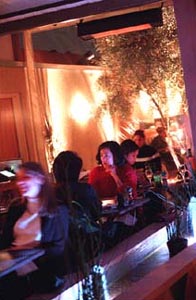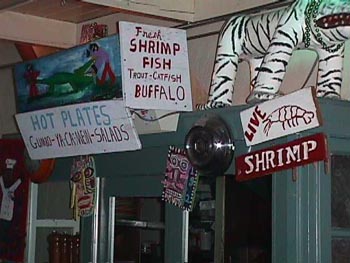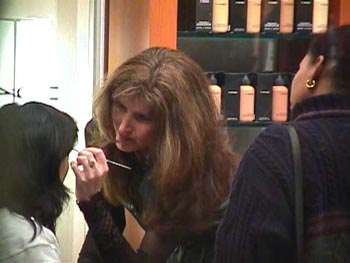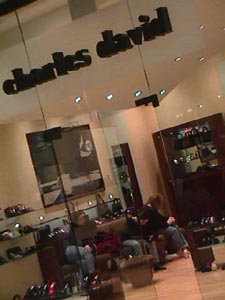![[Metroactive Features]](/features/gifs/feat468.gif)
![[Metroactive Features]](/features/gifs/feat468.gif)
[ Features Index | Metro | Metroactive Central | Archives ]
The New Silicon Valley
Christopher Gardner
Suddenly we're cool
Text by Dan Pulcrano
What should we make of the current international obsession with our region? Just a short time ago, Silicon Valley was San Francisco's unglamorous kid sister, the workhorse responsible for the family's economic prosperity while the older sibling got all the dates.
Now Europeans pay $3,000 for university-sponsored bus tours of Silicon Valley to glean insights from DigiCash, Exodus and E-Trade. Silicon Valley novels and bios clutter bookstores, and Time named a CEO down the street Man of the Year, an honor usually reserved for popes and heads of state.
That's the mythic Silicon Valley, though. The one we live in is a place with lottery billboards and self-service gas pumps, where we put on our 501s one leg at a time. For the 2 million of us who won't make the cover of Time this year, our collective celebrity means more time staring at brake lights--and possibly a rent increase.
Still, fame has its benefits. In less than three years, the former Valley of Heart's Delight has gone from backwater to one of the most admired places on Earth. Suddenly we're cool.
The almost-overnight transformation of our public standing and economic station is irrevocably altering the valley's physical landscape. Historic buildings are falling and fields are sprouting multi-story buildings with prominent, shapely entries. It's hard to drive a block on any major street without seeing a construction sign.
The changes, however, are even more far-reaching--simultaneously profound and subtle--as the valley undergoes a cultural revolution as well.
The New Silicon Valley is anything but provincial. It's cosmopolitan, international, culturally diverse, multidemoninational, unisex, right brained, eclectic and gay. It collects great books, old motorcycles and commercial-grade kitchen appliances. It likes ska, rockabilly, techno, angry folk and symphony. It sucks down triple lattes and wheat grass juice. It dresses stylishly casual.
No, we don't wear pocket protectors and drive K-cars anymore. The 1998 Index released this month by the Joint Venture Silicon Valley consortium missed these subjective facts. Our collective existence and the quality thereof, of course, cannot be reduced to graphs of income, housing, transportation and employment statistics. So, if government and industry bean counters want to ignore those things that make life worth living, we might as well give it a try.
The Hole Earth Index
When I moved to Silicon Valley in the early 1980s, a metaphor for the valley's cultural underdevelopment was the fact that you had to drive clear across the valley or over to Santa Cruz for a decent bagel. This is no longer a problem.
With at least three dozen bagel bakeries in the county, the bigger question in 1998 is whether we want our bagels boiled, baked or posh. In Campbell, Willow Glen, Los Gatos and Palo Alto there are competing bagel shops on the same block or right across the street from one another.
Just as political historian Thomas Friedman advances the Golden Arches Theory of Conflict Prevention, which postulates that when nations reach the level of economic and social development to support McDonald's franchises they lose interest in fighting wars, I have developed an index measuring an area's cultural evolution that I call the bagels-to-donuts index.
It simply involves searching an area's electronic telephone listings for the words bagel and donut (as well as the plural forms of those words and the alternative spelling "doughnut"), then dividing the results into a ratio. Using this methodology, we find that Santa Clara County has about 2.5 times as many donut-related businesses as bagel enterprises, which indicates it is significantly more culturally evolved than California overall (4:4), Texas (6:7) or Mississippi (11:7). In New York, the ratio is reversed, with 1.7 times the number of bagel purveyors than vendors of the sweet, deep fried pastry.
This analysis, while informative in quantifying an area's insularity and openness to outside influences, is not perfect, however. Inexplicably, Utah beats New York with a 2.8 ratio in favor of bagels.
Aside from statistical aberrations, the model holds up well. The region's donut capital, Hayward, for example, has a 14-to-1 bagel deficit, and no one has ever accused Hayward of being the area's intellectual and cultural nexis. Milpitas lists six donut shops and no bagelry, though it has a Borders bookstore, effectively refuting any loose allegations that it's a complete cultural wasteland.
Spago West, Young Flan
Silicon Valley does not live on flour and water alone, of course. When word of Silicon Valley's exploding wealth reached people who have built their careers feeding the rich, celebrity chefs from San Francisco to Los Angeles clamored for a share of the IPO crowd's meal money.
The owners of San Francisco's Lulu opened Zibibbo in a wood frame house on a downtown Palo Alto side street, identified by sign illuminated by a cool blue glow. Just about any night of the week in Zibibbo's warmly lit bar you'll find a crowd with expensive haircuts enmeshed in conversation over oysters, French wine and cocktails in stemware.
Around the corner, culinary entrepreneur Wolfgang Puck set up shop under his flagship brand, Spago. Puck joined a rapidly emerging gourmet gulch that appeals to the international sensibilities of the new Silicon Valley by authentically recreating a wide range of foreign and exotic cultures: Southern France (Zibibbo), Havana (La Bodeguita del Medio), Sicily (Palermo), Greece (Evvia), New Orleans (Nola) and Los Angeles (Spago).
"There is a cultural shift going on from the people who have been here for generations to the arrivistas," believes Applied Materials exec Tom Hayes. "We're seeing people who have traveled and have a global world view--and they have a demand for new tastes, whether it be in restaurants or culture. That is a big thing for a place that was an agricultural community just a generation ago."
"People my age still talk about [growing up amidst] orchards and pruneyards," adds Hayes, who is in his mid 30s.
Chris Fernandez, the barely thirty-somethingforce behind Palo Alto's Crescent Park Grill, migrated from the East Bay to be where the action is. "I wanted to be pioneering," he says.
His goal was to provide casual bistro-style cuisine as an alternative to "old style French," and he believed that Silicon Valley was ready with the boom of the past couple of years. "There is a good, sophisticated palate here," he observes.
"The expansion happened so fast that it rolled over the culture. People weren't paying attention to the culture. Now, it's kind of a catching-up period."
With Palo Alto's emergence as the playground for Silicon Valley's young money a done deal, Fernandez sees the next frontier in the area's urban evolution. "I think what needs to happen is San Jose needs to fire up more," he says.
Our Urban Decay
The first time I saw San Jose was back in the carefree days when a 16-year-old could hitchhike without worrying about getting picked up by Lawrence Singleton. My buddy Mike and I had made it from San Diego to the Capitol Expressway freeway ramp, where we stood for four hours. Someone before us had written on the guardrail, "I've been here so long, the mayor asked me for rent."
It was an unfriendly landscape of brown homes, freeway retainer walls and suburban desolation. Silicon Valley's companies in the '70s were populated by a generation that had come of age during the Korean war and enrolled in the defense-driven production economy ignited by post-Sputnik Cold War arms race.
The next wave of companies began to take on some of the characteristics of a generation that dropped acid, dodged or resisted the Vietnam war and hacked free calls from the phone company. These guys paved the way for the new Silicon Valley even if they spent too much time in hot tubs and wore their hair too long after it went out of fashion.
The '80s became a perverse caricature of nouveau riche behavior as more Silicon Valley denizens joined the leisure class. Cocaine and Ferraris and big homes on the mountain, limousines and valet parking. Big sound systems. Oak reproduction furniture.
As the decade faded into the '90s and the boom cooled, the word somehow got around that conspicuous consumption was out. Silicon Valley loosened its ties and abandoned the hard-sided briefcases. A new sense of style emerged.
Clothier Rhonda Lackmann, who owns the Alta shops in downtown San Jose, Willow Glen and San Carlos, has noticed a marked shift in the the clothing habits of Silicon Valley's women. "People are much more casual now," she says. "People can wear whatever they want. They can work all week in jeans and a T-shirt. People seem to be more secure in their positions and can express their personality."
Customers at her boutiques, which specialize in loosely cut clothes made from natural fibers by small designers, favor "soft suiting" rather than the tailored "Talbots woman," a reference to the conservative, East Coast-style clothier.
The shift was evident last week in a Netscape conference room, where a product team was delivering a client demo. With short, smart hair cut to precise angles, an Asian woman circled the room in snug-fitting velvet pants. Another wore faded, baggy jeans. The product manager, a thirtysomething man, wore brown cords, a thick belt and small oval lens glasses. Even the sales lead was tieless.
The market shift hasn't escaped the keen eyes of merchandisers. Stroll the formal, carpeted boulevards of the recently renovated Valley Fair Shopping Center, and you'll see crowds gathering at Mac, a contemporary line of urban cosmetics, right next to Charles David, an L.A.-based shoe line catering to young professional women. Just across the hall, Nordstrom carries a line of cosmetics called "Urban Decay." Its manufacturer, run by a co-founder of Cisco Systems, is based in Mountain View.
Clearly, we're not in Kansas anymore. Silicon Valley is dressing better, eating better, producing hit music. Its retail and cultural offerings are beginning to approach those of more mature areas.
A new generation with an appetite for a better life is driving the changes. Interestingly, Silicon Valley's newly affluent young seem to be eschewing some of the nouveau riche clichés that corrupted earlier waves of upward mobility. The conspicuous consumption is less grotesque, and the overnight millionnaires aren't acting like Beverly hillbillies either.
Gil Beyda, chief technology officer of the New York-based Internet marketing firm RealMedia, remarked on the chameleon-like quality of Silicon Valley's young elite during a recent visit here. He theorized that the process of acculturation was occuring simultaneously with rising incomes, rather than waiting a generation.
"Before, you would have their children reared in proper schools to acquire the refinement equal to the class they had become part of," Beyda said. "But here, it has skipped a generation. They are refining their own behavior to fit the class they have earned into."
The Silicon Valley "essence, spirit and zeitgeist" is something Applied's Hayes wants to take on the road when his Silicon Planet music and technology party pitches tent in six cities later this year. He thinks there is "a unique culture associated with technology and Silicon Valley that is optimistic, tolerant and demanding."
Still, he thinks, there is work locally to be done. "We have to focus on culture and amenities--the things that make a community attactive and livable," Hayes says. "Style and hipness, if you will."
Demand for just that will increase as SIlicon Valley further transforms from a post-agricultural community heavily influenced by the sensibilities of aerospace and computer hardware engineers to a more mature urban environment populated by companies in such fields as media or design and the attendent creative talent that such industries attract. Since 1992, the defense and aerospace sectors have shed 16,000 jobs while software has become the biggest job creator.
You can find Silicon Valley's emerging sense of cool in San Jose at the tables of Cafe Leviticus, on the dance floor of Fuel and at the wine bar of Stratta; in Palo Alto in the cigar room of Bodeguito del Medio and beside the bubbling goldfish pools at Zibibbo; on Sunnyvale's Murphy Avenue, in downtown Campbell and in the CD stores along Bascom Avenue.
Just a couple of years into Silicon Valley's new era, it's a safe bet that the changes have only just begun.
The New Silicon Valley:
It's all about speed.
The next generation of movers and shakers.
Silicon Valley through the decades.
Also, novelist Po Bronson asks, "How do the new rich of Silicon Valley '90s compare to the new rich of the Wall Street '80s?"
[ San Jose | Metroactive Central | Archives ]
Copyright © Metro Publishing Inc. Maintained by Boulevards New Media.
![]()

Discriminating Tastes: Diners relax at Zibibbo, one of Palo Alto's upscale culinary arrivals.

 Cultural Chameleons
Cultural Chameleons
![[line]](/gifs/line.gif)
![[line]](/gifs/line.gif)
From the January 15-21, 1998 issue of Metro.